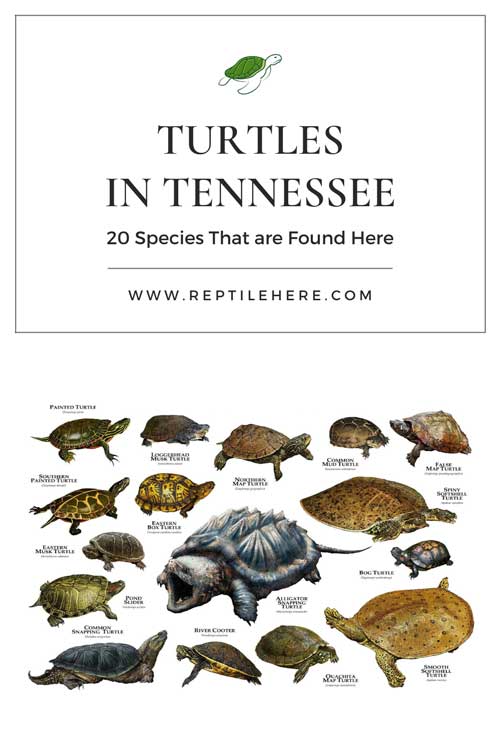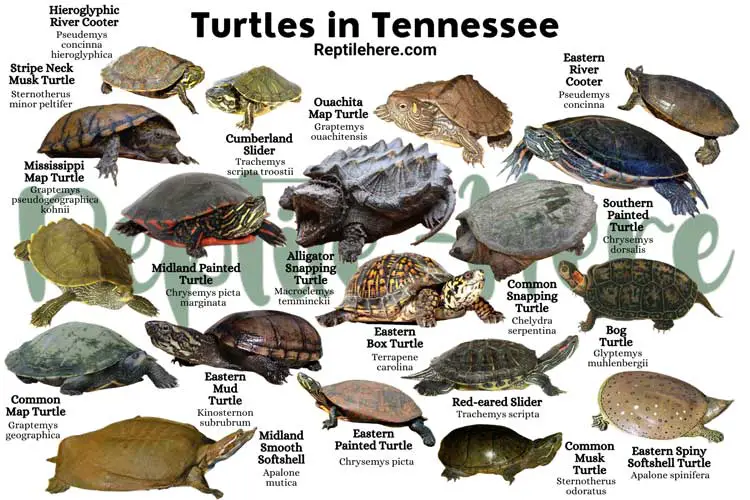Turtles in Tennessee – 20 Species That are Found Here
Tennessee is home to 20 native turtle species running from snapping turtles to several subspecies of painted turtles, softshell turtles, map turtles, and mud and musk turtles.
Most of these turtles are aquatic and inhabit Tennessee’s major rover systems like Mississippi, Cumberland, and Tennessee rivers.
Besides, the state is also home to 3 terrestrial turtle species namely the eastern box turtle, three-toed box turtle, and bog turtle which are state endangered.
As with most states, you can own one of these native turtles of Tennessee as long as you obtain the necessary documents. However, you can’t keep state-endangered species like the bog turtle.
The following list covers all the turtle species of Tennessee and the key traits and behavior that define them including physical appearance, habitat, diet, size, and other helpful info.
20 Types Of Turtles in Tennessee
Contents
1. Alligator Snapping Turtle
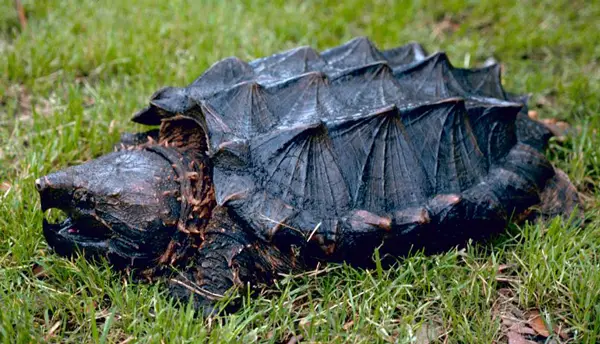
- Scientific name: Macroclemys temminckii
- Common name: Alligator snapping turtle, Snapping turtle
- Family: Chelydridae
- Size: 15 to 26 inches
- Lifespan: 80 to 120 years
- Conservation status: Vulnerable
The alligator snapping turtle is the largest freshwater turtle in Tennessee. This species is large than the common snapping turtle. An adult alligator snapping turtle weighs 15 to 20 inches long.
An alligator turtle is characterized by a long, tough shell with trigonal ridges that resemble the back of an alligator (hence the name alligator turtle).
Shell coloring can be black, olive, or brown. Though some people believe that the green tips on the shell ridges are natural, they’re simply algae.
These alligator turtles also prefer living in deeper waters of rivers, canals, lakes, and swamps in Tennessee.
As omnivorous species, they hunt their prey (but not actively). They have a unique way of hunting where they lie at the bottom of the water body and open their mouth to show their pink work-like appendage to lure their prey.
And when the prey gets close enough, the turtle ambushes it!
Another interesting fact about this sea turtle in Tennessee is its powerful jaws which can bite with a force of up to 1000lbs!
This makes them extremely dangerous turtles and should NEVER be handled in the wild! Mind you, they have injured even the most experienced herpetologists with their bites.
2. Common Snapping Turtle
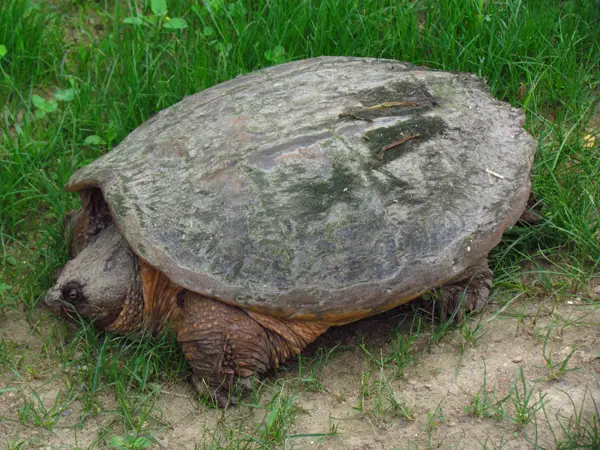
- Scientific name: Chelydra serpentina
- Common name: Snapping Turtle
- Family: Chelydridae
- Size: 8 to 18 1/2 inches
- Lifespan: 30 to 50 years or more
- Conservation status: Least Concern
Common snapping turtles are widespread throughout Tennessee. An average adult is pretty large and has a shell length of 18½ inches long.
This species has a chunky head, a long tail, and large webbed feet. The shell color is black or olive and has no distinct pattern. These Tennessee snapping turtles are known for their powerful jaws—they’re so strong that these turtles eat other turtles!
You’ll find them in waterbodies with muddy bottoms. Examples include marshes, ponds, lakes, rivers, and even shallow streams. They generally prefer waters with aquatic vegetation in plenty and foods such as fish, frogs, birds, etc.
These Tennessee turtles generally show docile behavior but can get quite aggressive if taken out of water. The best way to calm it is to take it back to the waters, where it feels safe.
3. Eastern Painted Turtle
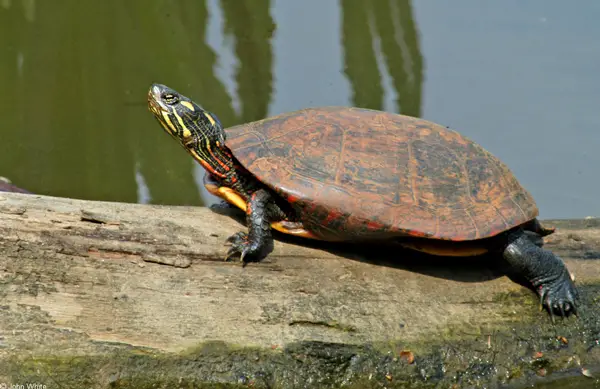
- Scientific name: Chrysemys picta picta
- Common name: Painted Turtle
- Family: Emydidae
- Size: 4 to 6 inches
- Lifespan: 30 to 50 years
- Conservation status: Least Concern
The Eastern painted turtle is one of the most recognizable turtle species in Tennessee, thanks to its beautiful and unique coloring.
The bright reds and yellow-green markings on its shell, head, and limbs are no doubt a beauty to behold!
This painted turtle sub-species in Tennessee has been observed to live near water bodies with minimal movements. Examples include marshes, ponds, slow-moving streams with sandy/muddy bottoms, small lakes, etc.
They also prefer areas with aquatic plants in plenty as they make their primary food source in the wild.
One interesting fact about these Tennessee turtles is their ability to hold their breath for up to 30 hours when inside temperate water. Moreover, they’re capable of standing dominant in freezing cold waters for up to 4 months.
Unfortunately, it’s not easy to establish the population of these turtles in Tennessee. This is because most people who pet them end up releasing them back into the wild.
This contributes to an ever-expanding range plus unstable reproduction rates for these turtles.
4. Midland Painted Turtle
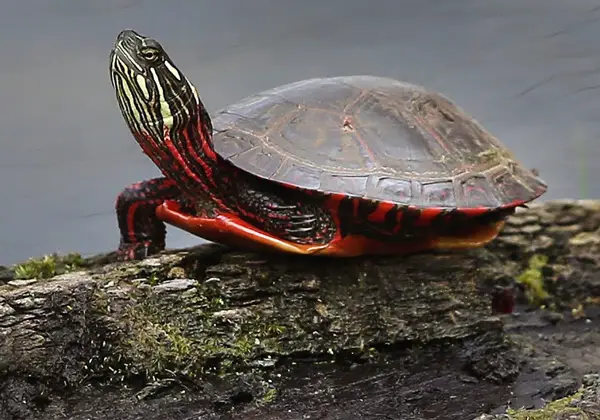
- Scientific name: Chrysemys picta marginata
- Common name: Midland Painted Turtle
- Family: Emydidae
- Size: 4 to 10 inches
- Lifespan: 20 to 40 years
- Conservation status: Least Concern
This is another subspecies of painted turtle you’ll find in Tennessee. Telling this specie apart from other painted turtles can be challenging since it lacks any unique features.
Nonetheless, a typical midland painted turtle has a dark-colored shell and skin that ranges from dark brown to black. Its shell usually features markings on its side, with colors from red to yellow.
The lower side of its shell is usually yellow in color. Don’t forget the skin is usually covered with lines than turn yellowish near the head and then change to red.
Just like the other painted turtles, this species prefers living in freshwater bodies in Tennessee. It can be found in slow-moving rivers, lakes, and ponds.
They’re also omnivorous and like feeding on aquatic vegetation as well as meat from insects, snails, shrimps, tadpoles, and earthworms.
5. Southern Painted Turtle
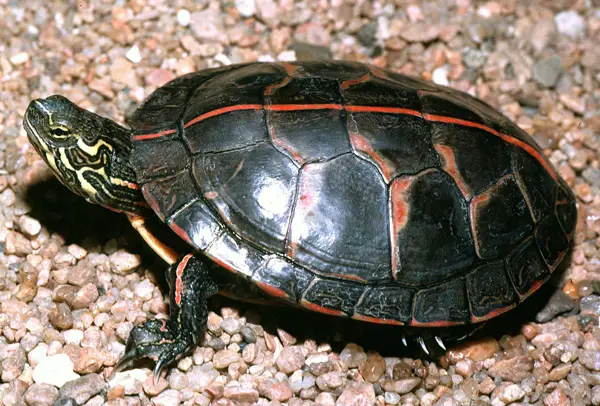
- Scientific name: Chrysemys dorsalis
- Common name: Painted Turtle
- Family: Emydidae
- Size: 4 to 6 inches
- Lifespan: 30 to 50 years
- Conservation status: Least Concern
The Southern painted turtle is a sub-species of painted turtle and the smallest of the painted turtle species in Tennessee. It prefers living in shallow water habits such as on edges of lakes and streams.
The average adult size ranges from 4 to 5 inches and is characterized by a distinctive orange or red stripe running down the back of its shell. They also feature a plain, pale-yellow skin belly (plastron) that’s sometimes lightly spotted.
Baby southern painted turtles tend to eat more meat and less vegetation. And as they grow up, they concentrate more on vegetation and less on animal matter.
Nonetheless, these turtles are omnivorous, just like other species. Some of the most common foods for this species include algae, duckweed, dragonfly larvae, and young crayfish.
Most folks like keeping these turtles as a pet due to their small size and unique color patterns on their shells. Not to forget they can live for quite a long time—up to 50 years—and most pet owners end up releasing them back into the wild in Tennessee.
6. Eastern Spiny Softshell
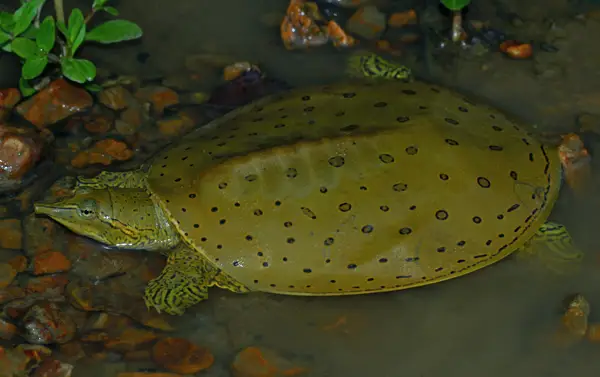
- Scientific name: Apalone spinifera
- Common name: Spiny Softshell Turtle
- Family: Trionychidae
- Size: 5 to 9 inches (males), 12 to 20 inches (females)
- Lifespan: 30 to 70 years
- Conservation status: Least Concern
The Eastern Spiny softshell turtle is a medium-to-large freshwater species that lives in the southwestern regions of Tennessee. To be more precise, Tennessee is home to two subspecies of spiny softshell turtles—eastern and gulf coast spiny softshells.
This turtle prefers lakes, streams, and rivers with muddy or sandy bottoms and little or no vegetation.
Spiny softshells generally have leathery, pancake-like shells. Both turtle subspecies have shell colors ranging from tan to brown.
The gulf coast has a series of black bars that run around the rim of its shell and ring markings on the upper shell. And this distinguishes it from the eastern spiny shell.
Eastern Spiny softshell turtles of Tennessee are mainly carnivorous and like eating anything they find in the waters including crayfish, insects, small fish, and so on.
They hunt by burying themselves in the mud or sand while keeping their head uncovered to grab food as it swims by.
7. Midland Smooth Softshell
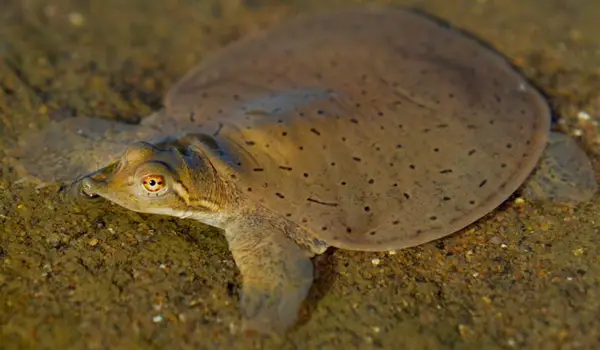
- Scientific name: Apalone mutica
- Common name: Midland Smooth Shell
- Family: Trionychidae
- Size: 6 to 13 inches
- Lifespan: 40 to 60 years
- Conservation status: Least Concern
The midland smooth softshell turtle boasts its position as the fastest turtle on land in Tennessee! Though most people believe these turtles are slow-moving, they must be quick to enable them to outrun their predators given that their soft shells don’t offer much protection.
Shell color of this turtle species ranges from olive to dark brown. The upper part of its shell features dark markings (with female markings appearing in a blotchier pattern than the males’)
The shell of these turtles also appears rounder and flatter, just like other softshell species.
Note that Gulf Coast smooth turtle (Apalone calvata) is the closes relative of this Midland smooth softshell turtle. The main difference existing between these two species is size, with the Gulf coast turtle reaching a maximum of 12 inches long.
Also, the Gulf coast species has no lines on its face while the midland smooth softshell turtle does.
These turtles like inhabiting waterbodies like rivers and streams in Tennessee that provide an abundance of mud or sand at the bottom. They can also be found in stagnant waterbodies.
Midland smooth softshell turtles are omnivorous and their diet revolves around aquatic vegetation and insects. However, they have been observed to like meat more than plant matter and will mainly eat snails, insects, and fish.
8. Common Map Turtle
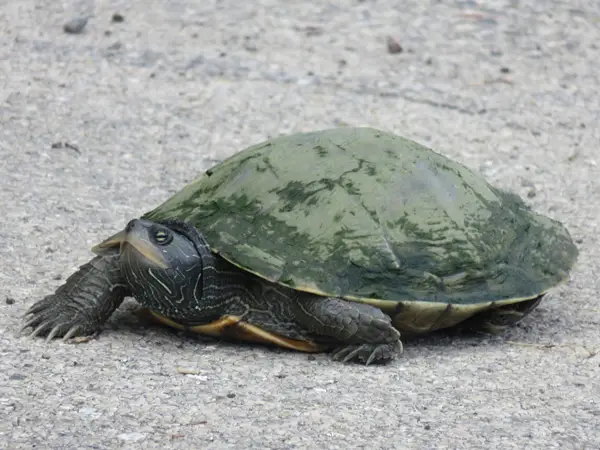
- Scientific name: Graptemys geographica
- Common name: Common Map Turtle, Northern Map Turtle
- Family: Emydidae
- Size: 3 to 10 inches
- Lifespan: 30 to 50 years
- Conservation status: Least Concern
The common map turtle is another species that inhabits Tennessee. To be more specie, this freshwater turtle resides in the rivers and lakes of Tennessee.
They prefer living in large waterbodies with debris. These offer the perfect spots for basking while the water bodies enable them to spend their hibernation periods in winter completely submerged.
Like other map turtles, this common map turtle gets its name from the map-like pattern on its shell. Its shell is typically darker and ranges from brown to black. The map pattern has a lighter coloration.
The common map turtle of Tennessee is mainly carnivorous and feeds on mollusks such as clams and snails. It will also eat crayfish and insects. And when animal matter gets scarce, it will feed on plant matter.
Note that it may be difficult to spot a common map turtle in the wild in Tennessee. Although active during the day, these turtles are quite timid and will quickly retreat to the waters at the slightest disturbance.
9. Mississippi Map Turtle
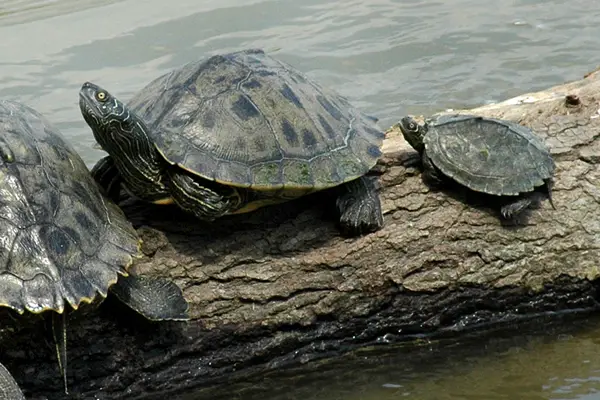
- Scientific name: Graptemys pseudogeographica kohnii
- Common name: Mississippi Map Turtle, Map Turtle
- Family: Emydidae
- Size: 3 to 5 inches (males), 8 to 10 inches (females)
- Lifespan: 30 to 50 years
- Conservation status: Least Concern
The Mississippi map turtle is also found in Tennessee. It gets its name from Mississippi Valley, the area where the species are widespread.
This map turtle of Tennessee has its upper shell with olive green or brown color, while the scutes feature a brighter color and are covered with patterns resembling a map.
The underside of the shell of this turtle is usually tan or yellow and has darker brown stripes.
You’ll find this turtle in Tennessee in slow-moving or stagnant waters with plenty of vegetation to act as their source of food. The most common habitats include slow-moving streams, rivers, ponds, and lakes.
Since these turtles of Tennessee are omnivorous, they’ll eat meat, insects, vegetables, fruits, and aquatic vegetation, to name but a few.
Note that a Mississippi map turtle of Tennessee makes a perfect turtle for a beginner turtle owner.
Also read: Turtles in Indiana
10. Ouachita Map Turtle
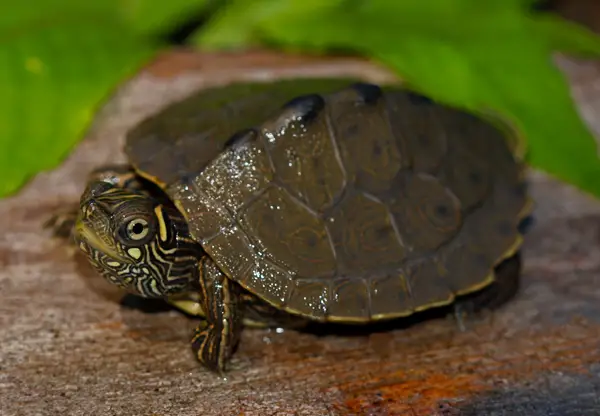
- Scientific name: Graptemys ouachitensis
- Common name: Ouachita Map Turtle, Map Turtle
- Family: Emydidae
- Size: 3 to 5 inches (males), 8 to 10 inches (females)
- Lifespan: 30 to 50 years
- Conservation status: Least Concern
The Ouachita map turtle lives in the swift rivers and streams forming the Mississippi River and its tributaries in Tennessee.
It is regarded as one of the less popular map turtle species. The turtle makes an excellent choice of pet for many people since it’s easy to care for.
As for its name, this species is named after the river where it was discovered—Ouachita!
Ouachita turtle is medium to large in terms of size. The average adult female is 3-5 inches long while the male is 8 to 10 inches long. It features thin, yellowing lines that form a web on the turtle’s shell (similar to a contour elevation map).
Moreover, the turtle has brown to olive coloring, with a light spot under both eyes.
The easiest way to identify this Tennessee turtle species from other map turtle subspecies is by checking the dots on its face. They usually have 3 prominent spots—under the jawline, under the eye, and behind the eye.
Note that this turtle prefers living in stagnant or slow-moving waters, including ponds, lakes, and streams in Tennessee.
It also prefers waters with plenty of vegetation. This species is omnivorous and eats meat, insects, vegetables, fruits, aquatic vegetation, etc.
11. Eastern Mud Turtle
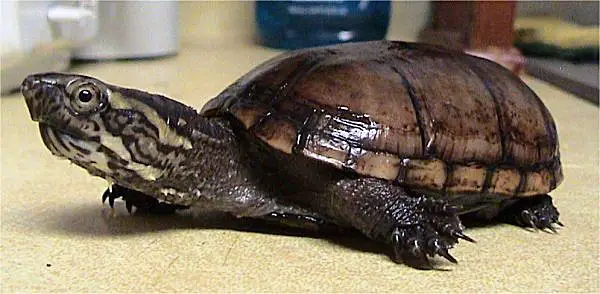
- Scientific name: Kinosternon subrubrum
- Common name: Eastern Mud Turtle, Mud Turtle
- Family: Kinosternidae
- Size: 3 to 5 inches
- Lifespan: 50 years
- Conservation status: Least Concern
The Eastern Mud turtle in Tennessee is found in shallow waters including ditches, marshes, wet meadows, and swamps.
This smaller aquatic turtle species is characterized by a smooth and unmarked shell. Yes, it has an incredible plain look, with its upper shell lacking any patterns. The carapace color ranges from dark yellow to black.
The lower side of the shell is also pretty plain, though it usually appears lighter on the upper part. The key distinction of this mud turtle is the stripes on its head which can be white or yellow in color.
One particular feature that sets this turtle apart from others and makes it easily identifiable is the hinges on its lower shell which form a “K” shape when viewed from the sides.
Just as its name suggests, this turtle lives in water bodies with a soft muddy, or sandy bottom. Thus, they can be found in marshes, swamps, and rivers in Tennessee.
Since the Tennessee eastern mud turtle is omnivorous, it eats meat, fish, snails, insects, and aquatic vegetation as well as plant matter on land.
Unlike other turtles, eastern mud turtles do not hibernate in the cold winter months. Instead, it does the opposite—it becomes dormant in the hot months of summer (this is known as aestivation).
12. Common Musk Turtle
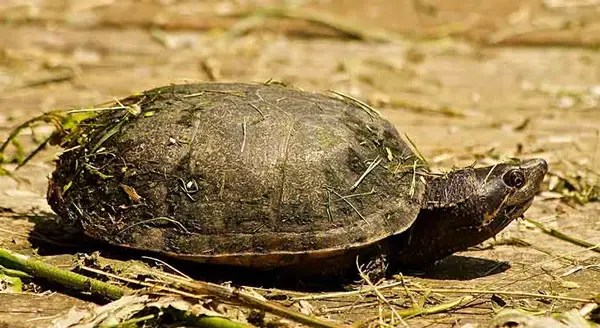
- Scientific name: Sternotherus odoratus
- Common name: Common Musk Turtle, Eastern Musk Turtle, Musk Turtle, Stinkpot
- Family: Kinosternidae
- Size: 2 to 4.5 inches
- Lifespan: 30 to 50 years
- Conservation status: Least Concern
The Common Musk Turtle is another aquatic turtle found in Tennessee’s slow-moving and sluggish streams as well as still water bodies.
The turtle usually prefers areas with dark crevices, where it can easily hide. It also prefers lots of plant matter to burrow in and hide.
An average adult eastern musk turtle is quite small (2 to 4.5 inches long). It has a pretty plain appearance with highly consistent colors. Both the shell and skin usually share the same color and can range from dark brown to black.
The turtle shell has one unique feature—a ridge traversing its entire shell length. Besides, it has another distinctive feature: two light-colored stripes on its head.
Common musk turtles of Tennessee are herbivorous and will eat small aquatic or semi-aquatic animals, carrion, and aquatic vegetation. They will also feed on any other vegetation on land.
When it feels threatened, this musk turtle species emits a foul odor (a musky odor, hence its name). This scent can be detected in water or on land. It can also easily waft through the air to its predators.
Also, these Tennessee turtles are good at climbing trees! This great capability enables them to go high up tree branches to find a safe resting place and avoid predators.
13. Stripe Neck Musk Turtle
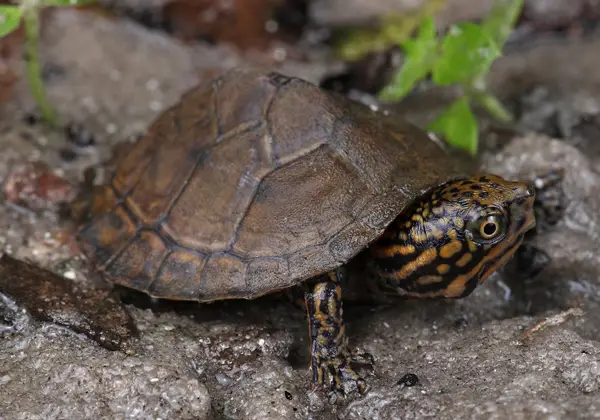
- Scientific name: Sternotherus minor peltifer
- Common name: Stripe-necked Musk Turtle
- Family: Kinosternidae
- Size: 3 to 4.5 inches
- Lifespan: 20 to 50 years
- Conservation status: Vulnerable
The Striped-necked musk turtle is a subspecies of loggerhead musk turtle that lives in Tennessee. This small aquatic turtle has a larger head compared to other musk turtles.
This turtle is highly aquatic and likes living in streams as well as rivers in the mountains. Mind you, this turtle has only been spotted in two counties of Tennessee.
The most distinguishable feature of this musk turtle is the numerous dark stripes that line its neck and head. its carapace is keeled and is gray or brown in color.
The carapace may sometimes feature dark spots or streaks. Its plastron is yellow and unspotted.
In terms of diet, this turtle species of Tennessee is omnivorous but mainly likes eating aquatic insects and small snails. it is diurnal and tends to conduct its foraging in the morning hours.
14. Eastern River Cooter
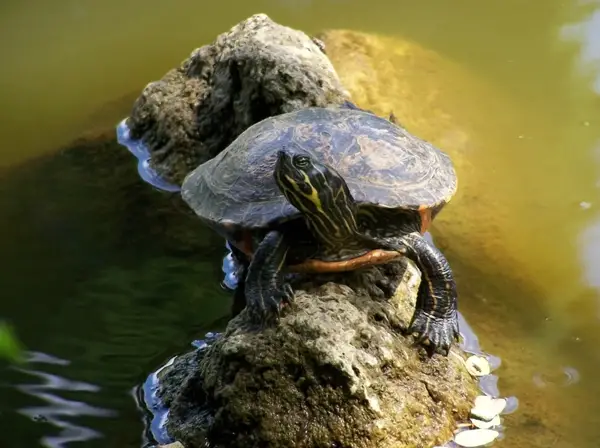
- Scientific name: Pseudemys concinna
- Common name: River Cooter
- Family: Emydidae
- Size: 8 to 12 inches
- Lifespan: 20 to 40 years
- Conservation status: Least Concern
River Cooter turtles are also inhabitants of Tennessee state. They’re known to be solitary creatures and often like basking alone in the sun. However, they can be sometimes observed sharing habitat with painted turtles and red-eared sliders.
They’re distinguishable by their brown to olive or dark-green outer shell and lighter c-shaped, concentric markings in their scutes. Their skin can be olive or olive-brown in color, with numerous yellow lines.
Most of these turtle adults are around 8 to 12 inches in size, though it’s not rare to come across females with a bigger size—up to 15 inches.
These turtles are pretty fast both on land and in water. They’re found in various freshwater bodies including lakes, ponds, and rivers in Tennessee. They’re also found in brackish water.
Their diet is primarily herbivorous and mainly consists of various forms of aquatic vegetation and land plant matter, including fruits and vegetables. They’re however known to occasionally feed on insects and snails.
15. Hieroglyphic River Cooter
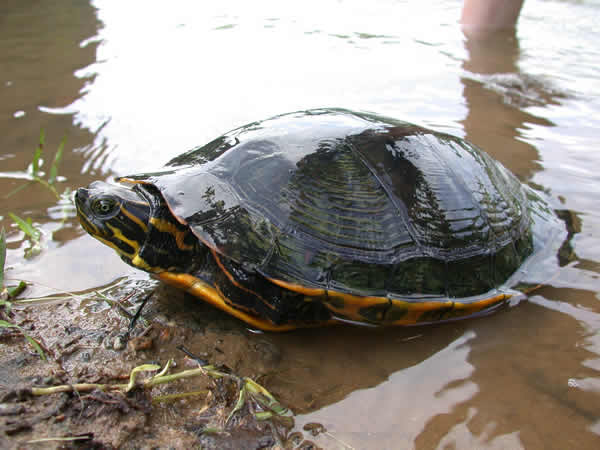
- Scientific name: Pseudemys concinna hieroglyphica
- Common name: River Cooter
- Family: Emydidae
- Size: 8 to 12 inches
- Lifespan: 20 to 40 years
- Conservation status: Least Concern
River Cooter turtles are also inhabitants of Tennessee. They’re known to be solitary creatures and often like basking alone in the sun.
However, they can be sometimes observed sharing habitat with painted turtles and red-eared sliders.
They’re distinguishable by their green-brown or black carapace with red or orange patterns resembling hieroglyphics. Their plastron is light colored while the skin is covered with pronounced stripes ranging in color from yellow to orange or red.
Most of these turtle adults are around 8 to 12 inches in size, though it’s not rare to come across females with a bigger size—up to 15 inches.
These turtles are pretty fast both on land and in water. They’re found in various freshwater bodies including lakes, ponds, and rivers in Tennessee. They’re also found in brackish water.
Their diet is primarily herbivorous and mainly consists of various forms of aquatic vegetation and land plant matter, including fruits and vegetables. They’re however known to occasionally feed on insects and snails.
16. Cumberland Slider
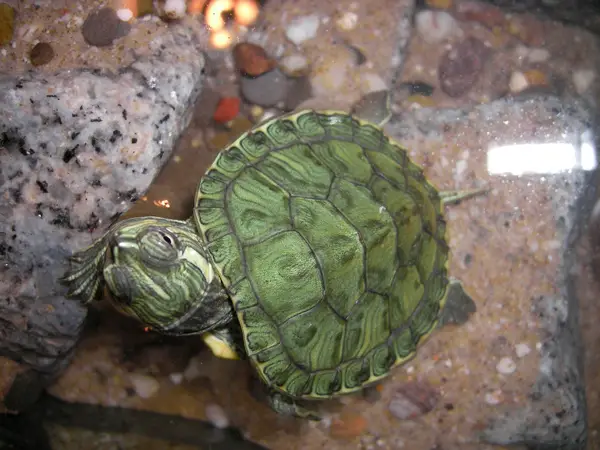
- Scientific name: Trachemys scripta troostii
- Common name: Cumberland turtle, Troost’s turtle
- Family: Emydidae
- Size: 7 to 11 ½ inches
- Lifespan: 40 to 50 years
- Conservation status: Least Concern
The Cumberland is a subspecies of pond sliders, making it a close relative of yellow-bellied sliders and red-eared sliders. The turtles are native to the Southeastern United States.
And in Tennessee state, they live in the Tennessee and Cumberland river systems.
These medium-sized semi-aquatic turtles’ upper shells range from olive green to brown and feature yellow markings. They also feature yellow stripes behind their eyes.
The lower side of the shell is usually yellow with several black spots. Skin color is usually olive, green, or black, and has multiple yellow stripes.
Cumberland sliders of Tennessee live are omnivorous and feed on insects, mollusks, worms, dark leafy land vegetation, and aquatic vegetation.
17. Red-eared Slider
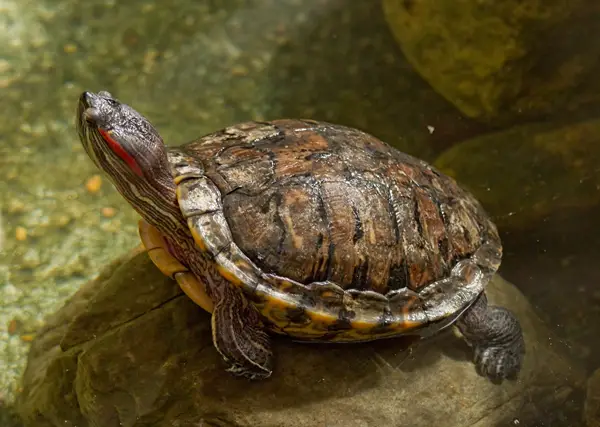
- Scientific name: Trachemys scripta
- Common name: Red-eared Slider, Red-eared Terrapin
- Family: Emydidae
- Size: 7 to 11 inches
- Lifespan: 30 to 40 years
- Conservation status: Least Concern
The red-eared slider is a sub-species of pond sliders and a native species of Tennessee. It is a semi-aquatic turtle and prefers living in marshes, ponds, lakes, and creeks.
A red-eared slider gets its name from the small red stripe surrounding its ears (or behind the eye), and its ability to quickly slide off logs and rocks into the water.
Generally, the skin and shell coloration of this slider can be brown or black, with yellow stripes covering the skin.
The red-eared sliders of Tennessee are pretty large and the adults reach 7-12 in length (though females are generally larger than males).
These Tennessee pond sliders are omnivorous and like eating fish, snails, insects, and aquatic vegetation. They also eat land vegetation, including fruits and vegetables.
18. Bog Turtle
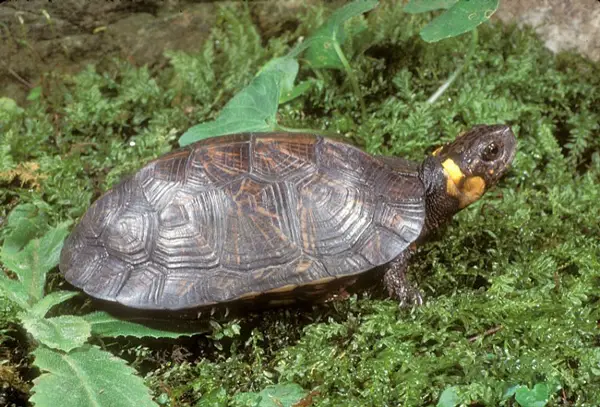
- Scientific name: Glyptemys muhlenbergii
- Common name: Bog Turtle, Muhlenberg’s turtle
- Family: Emydidae
- Size: 3.5 to 5 inches
- Lifespan: up to 40 years
- Conservation status: Critically Endangered
The Bog turtle is the smallest aquatic turtle you’ll find in Tennessee and in North America.
The species is critically endangered and is one of the rarest turtles in the state; it is only seen in the western counties of Tennessee.
Mind you; selling or owning a bog turtle in Tennessee is illegal!
An adult bog turtle’s carapace coloration ranges from black to olive or dark brown and features a central keel ridge. Some of the scutes making up their upper shell may also bear red or yellow-star markings. And their heads have distinctive orange or yellow patches.
The bog turtle is known to inhabit wetland areas such as marshes or bogs populated with grass cover.
The turtle species are diurnal omnivores and like eating insects, mollusks, and occasional vegetation. They’re most active during warm parts of the day.
19. Eastern Box Turtle
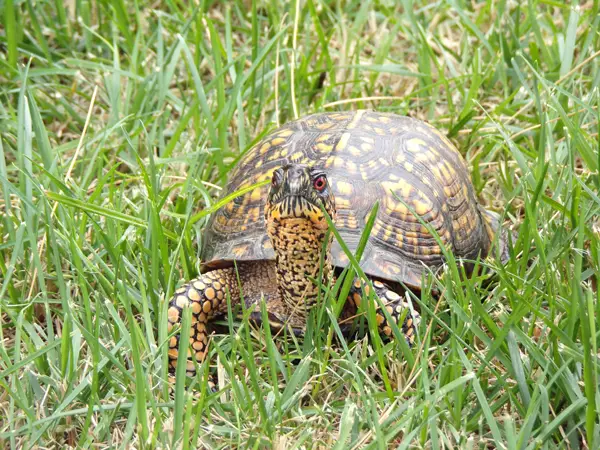
- Scientific name: Terrapene carolina
- Common name: Eastern Box Turtle, Land turtle, Box Turtle
- Family: Emydidae
- Size: 4.5 and 7 inches
- Lifespan: 50 to 100 years
- Conservation status: Vulnerable
The eastern box turtles are also present in Tennessee. They prefer these areas due to abundant access to sunlight and food sources nearby.
An adult turtle of this species is about 4.5 to 7 inches and weighs just 2lbs. It has a high, domed shell shape with a ridge running from head to toe. The shell of this turtle has varying colors of olive, brown, and tan.
The variation in markings on the shells of these turtles is so variable that you can’t easily recognize one by looking at the shell alone.
These eastern box turtles of Tennessee are omnivorous and feed on a variety of foods including insects, meat, fruits, vegetables, and various types of vegetation.
Note that eastern box turtles are taken from the Tennessee wild for pet trade, leading to a decline in their population. For this reason, many states have illegalized capturing and selling of this species.
And those in captivity end up dying due to poor conditions or being abandoned or released back into the wild because they’re too demanding to maintain.
20. Three-toed Box Turtle
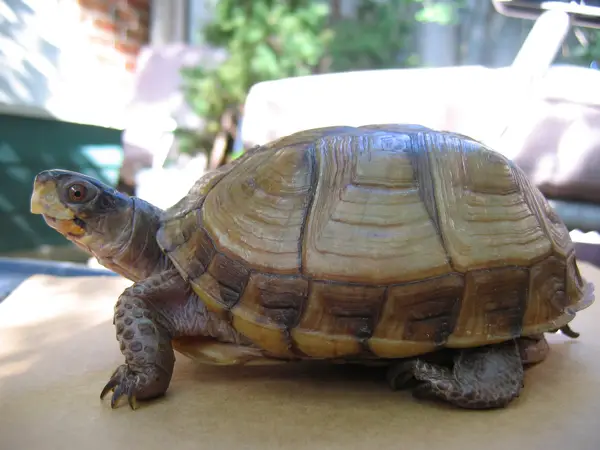
- Scientific name: Terrapene triunguis
- Common name: N/A
- Family: Emydidae
- Size: 4.5 to 5 inches
- Lifespan: 50 and 100 years
- Conservation status: Vulnerable
The three-toed box turtles inhabit the thickets, prairies, and woodlands of Southwest Tennessee. They’re easily identifiable by the 3 toes on their hind limbs, unlike the usual 4 toes on other box turtle species.
They have a uniform olive to brown shell color, sometimes with light spots or streaks. Bright yellow or orange spots are also occasionally spotted on the turtle species’ head and leg.
A mature three-toed box turtle has an average size of 4.5 to 5 inches.
They are unlike other box turtles in that they’re the only species that will remain healthy if you have them in indoor enclosures.
Being omnivorous in nature, these Tennessee turtles are known to eat snails, insects, earthworms, slugs, mushrooms, strawberries, and green-leafed vegetation. They have also been spotted eating quail eggs.
Related: Turtles in Hawaii
Conclusion
We have just discussed the 20 turtle species native to Tennessee state. Most of the turtles featured in the above list are semi-aquatic or fully aquatic and reside in major river systems of the state like the Cumberland, Tennessee, and Mississippi rivers.
These aquatic species include snapping turtles, painted turtles, map turtles, pond sliders, mud turtles, musk turtles, and others.
The state is also home to three species of land turtles including eastern box turtles, three-toed box turtles, and the bog turtle.
Note that the state endangered turtles like the bog turtle are state protected and therefore illegal to keep as a pet or to hunt, even with a valid hunting and fishing license from the state.
